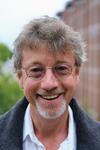Jonathon Howard
Mechanics of Motor Proteins and the Cytoskeleton
Mechanics of Motor Proteins and the Cytoskeleton The Howard lab is fascinated by the question of how small molecules like proteins, lipids and nucleotides self-assemble into cells and tissues that are thousands to millions of times larger than molecular dimensions. How do the molecules know where they should be, and whether the structures that they have made are the right size, shape and location? By combining highly sensitive techniques to visualize and manipulate individual biological molecules with theory and modeling, the Howard lab is trying to understand the interaction rules that allow molecules to work together to form highly organized yet dynamic cellular structures.
The Howard lab is approaching these questions in the context of the microtubule cytoskeleton. They are interested in the molecular properties of motor proteins and microtubule assembly regulators, especially how they operate as molecular machines to drive motion and regulate the growth and shrinkage of microtubules. In addition to biochemical and single-molecule approaches, they also study a number of cellular systems including the morphogenesis of neuronal dendrites, mitosis, mechanoreceptors, and cilia & flagella and. Specialized Terms: Microtubules, Motor proteins, MAPs, Cytoskeleton, Microtubule dynamics, Cell motility, Mitosis, the Axoneme, Optical tweezers, Single-molecule biophysics
Spastin is a dual-function enzyme that severs microtubules and promotes their regrowth to increase the number and mass of microtubules. Kuo YW, Trottier O, Mahamdeh M, Howard J. Spastin is a dual-function enzyme that severs microtubules and promotes their regrowth to increase the number and mass of microtubules. Proceedings Of The National Academy Of Sciences Of The United States Of America 2019, 116:5533-5541.
Heat Oscillations Driven by the Embryonic Cell Cycle Reveal the Energetic Costs of Signaling. Rodenfels J, Neugebauer KM, Howard J. Heat Oscillations Driven by the Embryonic Cell Cycle Reveal the Energetic Costs of Signaling. Developmental Cell 2019, 48:646-658.e6.
Force Generated by Two Kinesin Motors Depends on the Load Direction and Intermolecular Coupling. Khataee H, Howard J. Force Generated by Two Kinesin Motors Depends on the Load Direction and Intermolecular Coupling. Physical Review Letters 2019, 122:188101.
Label-free high-speed wide-field imaging of single microtubules using interference reflection microscopy. Mahamdeh M, Simmert S, Luchniak A, Schäffer E, Howard J. Label-free high-speed wide-field imaging of single microtubules using interference reflection microscopy. Journal Of Microscopy 2018, 272:60-66.
A force-generating machinery maintains the spindle at the cell center during mitosis.
Garzon-Coral C, Fantana HA, Howard J. A force-generating machinery maintains the spindle at the cell center during mitosis. Science (New York, N.Y.) 2016, 352:1124-7.
Dynamic curvature regulation accounts for the symmetric and asymmetric beats of Chlamydomonas flagella. Sartori P, Geyer VF, Scholich A, Jülicher F, Howard J. Dynamic curvature regulation accounts for the symmetric and asymmetric beats of Chlamydomonas flagella. ELife 2016, 5.
Quantitative cell biology: the essential role of theory. Howard J. Quantitative cell biology: the essential role of theory. Molecular Biology Of The Cell 2014, 25:3438-40.
A NOMPC-dependent membrane-microtubule connector is a candidate for the gating spring in fly mechanoreceptors. Liang X, Madrid J, Gärtner R, Verbavatz JM, Schiklenk C, Wilsch-Bräuninger M, Bogdanova A, Stenger F, Voigt A, Howard J. A NOMPC-dependent membrane-microtubule connector is a candidate for the gating spring in fly mechanoreceptors. Current Biology : CB 2013, 23:755-63.
Turing’s next steps: the mechanochemical basis of morphogenesis. Howard J, Grill SW, Bois JS. Turing’s next steps: the mechanochemical basis of morphogenesis. Nature Reviews. Molecular Cell Biology 2011, 12:392-8.
